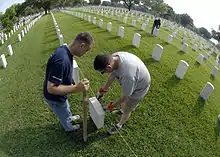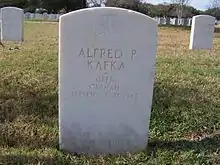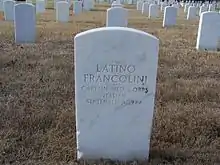Fort Sam Houston National Cemetery
Fort Sam Houston National Cemetery is a United States National Cemetery in the city of San Antonio in Bexar County, Texas. Administered by the United States Department of Veterans Affairs, it encompasses 154.7 acres (62.6 ha), and as of 2014, had over 144,000 interments. The cemetery was listed on the National Register of Historic Places in 2016.
 Fort Sam Houston National Cemetery, 2019. | |
| Details | |
|---|---|
| Established | 1926 |
| Location | |
| Country | United States |
| Coordinates | 29°28′32″N 98°25′27″W |
| Type | United States National Cemetery |
| Owned by | U.S. Department of Veterans Affairs |
| Size | 154.7 acres (62.6 ha) |
| No. of graves | 144,000 |
| Website | Official |
| Find a Grave | Fort Sam Houston National Cemetery |

History
Although the Army post in the area was established in 1875, and construction of Fort Sam Houston began the following year, no burials were made in the area that is currently the cemetery until 1926. In 1931 60 acres (24 ha) were added as an addition to San Antonio National Cemetery. In 1937, the addition became a National Cemetery in its own right, renamed Fort Sam Houston National Cemetery. In 1947 several other forts in Texas, including Fort McIntosh, were closed and their cemetery interments were transferred to Fort Sam Houston National Cemetery.
Interred at the Fort Sam Houston National Cemetery are 140 Axis prisoners of war (POWs) from World War II who died in captivity. 133 are German, 4 are Italian, and 3 are Japanese. These POWs were disinterred from various Texas prisoner of war camps and reburied at Fort Sam Houston National Cemetery. Among these POWs is Hugo Krauss, a German murdered by fellow German POWs at Camp Hearne in 1943. When originally interred, these graves were isolated from the American graves.
Two gravestones marked with swastikas were replaced on December 24, 2020. The Military Religious Freedom Foundation had demanded their removal in May 2020, but the Veterans Administration (VA) resisted on the grounds that they were historical. The VA resisted until Senator Ted Cruz (R-TX) and Congressen Will Hurd (R-TX23) and Kay Granger (R-TX12) put pressure on them.[1][2]



Notable interments
- Medal of Honor recipients
- Staff Sergeant Lucian Adams, for action in World War II.
- Master Sergeant Roy Benavidez, for action in the Vietnam War.
- Colonel Cecil Hamilton Bolton, for action in World War II.
- Staff Sergeant William J. Bordelon, for action at the Battle of Tarawa in World War II.
- Platoon Sergeant William George Harrell, for action at Battle of Iwo Jima in World War II.
- Second Lieutenant Lloyd Herbert Hughes, for action in Operation Tidal Wave in World War II.
- Private Milton A. Lee, for action in the Vietnam War.
- Sergeant First Class Jose M. Lopez, for action in World War II.
- First Lieutenant James E. Robinson, Jr., for action in World War II.
- Chief Warrant Officer Louis R. Rocco, for action in the Vietnam War.
- Master Sergeant Cleto Luna Rodriguez, for action in World War II.
- Colonel Seth Lathrop Weld, for action in the Philippine–American War.
- Other notable interments
- Colonel Charlie Beckwith, creator of 1st Special Forces Operational Detachment-Delta (Delta Force).
- Colonel Doc Blanchard, Heisman Trophy winner for 1945
- Brigadier General Oscar Bergstrom Abbott, Commanding General of Camp Beale during World War II.
- Brigadier General Bertram A. Bone, USMC; was a Commanding officer of 1st Defense Battalion during World War II.
- Major General Mary E. Clarke, was a director of the Women's Army Corps and the first woman to attain the rank of major general in the United States Army.
- Brigadier General Lillian Dunlap, former chief of the United States Army Nurse Corps, recipient of the U.S. Army Distinguished Service Medal, the Meritorious Service Medal, and the Army Commendation Medal (with oak leaf cluster).
- Gustavo "Gus" C. Garcia, Mexican-American civil rights attorney.
- Joseph A. Green, commander of Coastal Artillery Corps
- Robert Gottschall, actor working under the name Robert Shaw, and former United States Army Lieutenant Colonel.
- Lieutenant General Charles P. Hall, commanded the 93rd Infantry Division and XI Corps in World War II.
- General Henry I. Hodes, U.S. Army four-star general
- Major General Harry H. Johnson, commander of the 2nd Cavalry Division and 93rd Infantry Division during World War II.
- Brigadier General Charles I. Murray, USMC. A recipient of Navy Cross and Army Distinguished Service Cross.
- Brigadier General John L. Pierce, World War II commander of 16th Armored Division in European theater.
- Captain William Millican Randolph, namesake of Randolph Air Force Base.
- Major General Emil F. Reinhardt, World War II commander of 69th Infantry Division and IX Corps.
- Joe Sage, member of the Texas House of Representatives from Bexar County from 1973 to 1975
- Frank Tejeda, US Congressman.
- Colonel Gerald Evan Williams, Commander of the 391st Bombardment Group, 1943–1945
- Major General Roscoe B. Woodruff, World War II commander of 77th and 24th Infantry Divisions and VII Corps in both European and Pacific theaters.
- Other noteworthy interments
- 27 Buffalo Soldiers who served during the Indian Wars.
- 140 Axis prisoners of war from World War II.
- 4 British Royal Air Force officers from World War II.[3]
References
- "Pair of Nazi headstones removed from Houston Cemetery". news.yahoo.com. Yahoo News. AP. December 24, 2020. Retrieved December 24, 2020.
- "Headstones bearing Nazi swastikas were removed Wednesday from Fort Sam Houston National Cemetery". ExpressNews.com. 2020-12-23. Retrieved 2020-12-27.
- "Cemetery Details | CWGC". Commonwealth War Graves Commission. Retrieved 2020-12-27.
External links
- National Cemetery Administration
- Fort Sam Houston National Cemetery
- Historic American Landscapes Survey (HALS) No. TX-3, "Fort Sam Houston National Cemetery, 1520 Harry Wurzbach Road, San Antonio, Bexar County, TX", 45 photos, 4 photo caption pages
- U.S. Geological Survey Geographic Names Information System: Fort Sam Houston National Cemetery